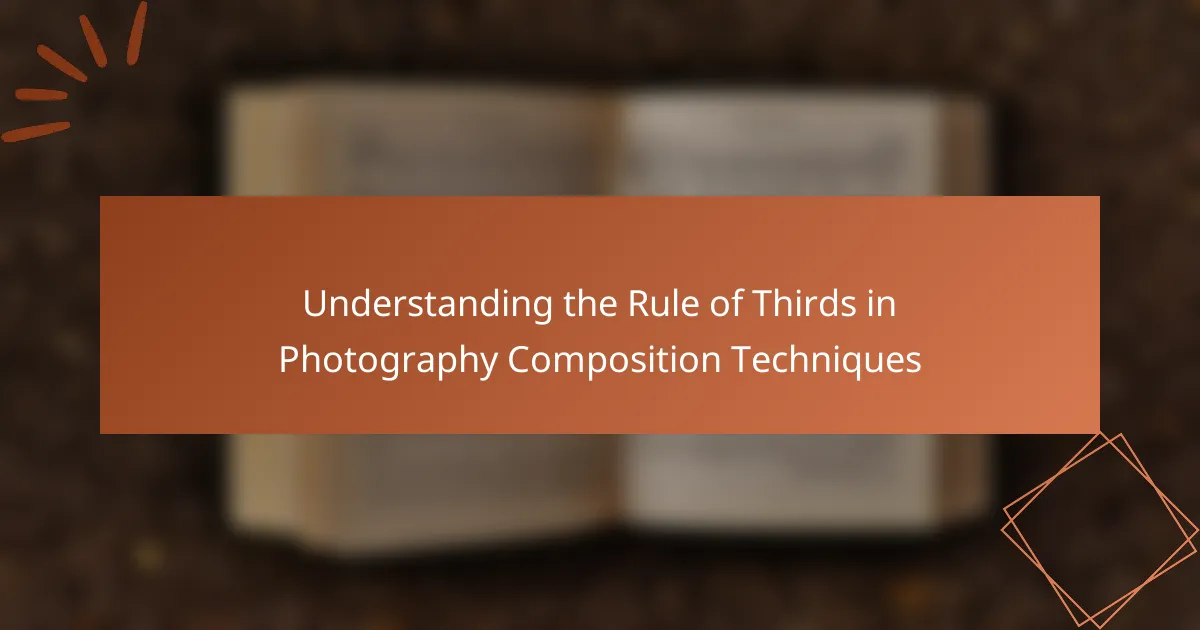The Art of Symmetry in Photography focuses on the balanced arrangement of elements within a frame to create visual harmony and appeal. This technique involves methods such as reflections, framing, and leading lines to emphasize the main subject and enhance overall composition. Challenges such as misalignment, distractions, and varying perspectives can complicate the achievement of symmetry. The article explores various techniques, common obstacles, and the emotional impact that symmetrical compositions can have on viewers, providing insights for photographers aiming to create striking and balanced images.

What is the Art of Symmetry in Photography?
The Art of Symmetry in Photography refers to the balanced arrangement of elements within a frame. This technique creates a sense of harmony and visual appeal. Symmetry can be achieved through various means, such as mirroring subjects or aligning lines and shapes. Photographers often use symmetry to draw attention to the main subject. It enhances the overall composition and can evoke emotional responses from viewers. Examples include reflections in water or architectural designs. The use of symmetry can lead to striking images that resonate with audiences.
How does symmetry enhance visual appeal in photography?
Symmetry enhances visual appeal in photography by creating balance and harmony. It draws the viewer’s eye to the focal point. Symmetrical compositions often evoke feelings of order and tranquility. This can lead to a more engaging and aesthetically pleasing image. Studies show that humans are naturally attracted to symmetrical patterns. Research by the University of California found that symmetrical images are more likely to be perceived as beautiful. Symmetry can also simplify complex scenes, making them easier to understand. Overall, it is a powerful tool for photographers aiming to create striking visuals.
What are the different types of symmetry used in photography?
The different types of symmetry used in photography include bilateral symmetry, radial symmetry, and asymmetrical balance. Bilateral symmetry occurs when elements are mirrored across a central axis. This type creates a sense of harmony and balance in the composition. Radial symmetry involves elements arranged around a central point, drawing the viewer’s eye inward. Asymmetrical balance, while not traditional symmetry, uses different elements to create a balanced composition without mirroring. Each type enhances visual appeal and guides viewer perception.
How does symmetry influence viewer perception in photographs?
Symmetry significantly influences viewer perception in photographs by creating a sense of balance and harmony. Photographs that exhibit symmetry are often perceived as more aesthetically pleasing. This visual appeal can evoke positive emotional responses from viewers. Research indicates that symmetrical compositions are easier for the brain to process. This ease of processing often leads to increased viewer engagement. Symmetry can also guide the viewer’s eye to focal points within the image. Additionally, symmetrical images can convey stability and order. These characteristics contribute to the overall effectiveness of a photograph in communicating its intended message.
Why is visual harmony important in photography?
Visual harmony is important in photography because it creates a sense of balance and coherence in an image. This balance helps guide the viewer’s eye and enhances the overall aesthetic appeal. When elements in a photograph are visually harmonious, they work together to convey a unified message or emotion. Research indicates that images with harmonious compositions are more likely to engage viewers and evoke positive responses. Studies show that balanced images can improve viewer recall and satisfaction. Therefore, achieving visual harmony is essential for effective photography.
What role does balance play in creating visual harmony?
Balance is essential in creating visual harmony. It ensures that elements within a composition are evenly distributed. This distribution can be symmetrical or asymmetrical. Symmetrical balance involves mirroring elements on either side of a central line. Asymmetrical balance uses contrasting elements to achieve equilibrium. Both types of balance contribute to a pleasing aesthetic. They guide the viewer’s eye throughout the image. Research shows that balanced compositions are perceived as more attractive. This perception enhances the overall impact of the photograph.
How can visual harmony impact storytelling in photography?
Visual harmony significantly enhances storytelling in photography. It creates a cohesive visual narrative that guides the viewer’s attention. When elements within a photograph are balanced and harmonious, they evoke emotions and convey messages more effectively. This balance can be achieved through symmetry, color schemes, and compositional techniques. For instance, a photograph with harmonious colors can evoke a specific mood, influencing how the story is perceived. Studies show that viewers are more likely to engage with images that exhibit visual harmony. This engagement leads to a deeper understanding of the story being told. Thus, visual harmony is a crucial element in effective photographic storytelling.

What techniques can be used to achieve symmetry in photography?
Techniques to achieve symmetry in photography include using reflections, framing, and leading lines. Reflections in water or glass create a mirrored effect, enhancing symmetry. Framing subjects with elements on either side can establish balance. Leading lines guide the viewer’s eye towards a central point, promoting symmetry. Additionally, utilizing the rule of thirds can help in positioning symmetrical elements effectively. Symmetrical compositions often evoke a sense of harmony and stability in images.
How can composition techniques help create symmetry?
Composition techniques help create symmetry by strategically arranging elements within a frame. Techniques such as the Rule of Thirds can guide the placement of subjects to achieve balance. Using leading lines can direct the viewer’s eye symmetrically across the image. Reflections in water or glass surfaces naturally create symmetrical compositions. Additionally, repeating patterns enhance visual harmony and balance. Symmetrical framing can evoke feelings of stability and order. By utilizing these techniques, photographers can effectively emphasize symmetry in their work.
What are the rules of composition that promote symmetry?
Symmetry in photography is achieved through specific composition rules. The first rule is to place elements evenly on either side of a central axis. This creates a mirror effect that enhances balance. The second rule involves using geometric shapes that naturally promote symmetry, such as circles or squares. Thirdly, the rule of thirds can be applied to achieve asymmetrical balance while still highlighting symmetric elements. Additionally, leading lines can guide the viewer’s eye towards the center, reinforcing symmetry. Lastly, framing elements symmetrically within the shot can enhance visual harmony. Each of these rules contributes to a cohesive and aesthetically pleasing image.
How can framing and perspective enhance symmetrical images?
Framing and perspective can significantly enhance symmetrical images by guiding the viewer’s eye and emphasizing balance. Framing creates a defined boundary, focusing attention on the symmetrical elements. This helps to isolate the subject, making the symmetry more pronounced. Perspective alters the viewer’s angle, adding depth and dimension. By choosing an optimal viewpoint, photographers can highlight the symmetry in a more impactful way. For example, shooting from a lower angle can amplify the sense of grandeur in symmetrical architecture. This technique can lead to a more engaging composition, inviting viewers to explore the image further.
What tools and equipment assist in capturing symmetry?
Tools and equipment that assist in capturing symmetry include tripods, levelers, and specialized cameras. Tripods provide stability, ensuring that the camera remains in a fixed position. This helps maintain symmetrical framing. Levelers ensure that the camera is perfectly horizontal or vertical. This is crucial for achieving balanced compositions. Specialized cameras with grid overlays aid in aligning subjects symmetrically within the frame. Additionally, software tools for post-processing can enhance symmetry in images. These tools allow for adjustments that correct any minor deviations. Overall, these tools are essential for achieving visual harmony in photography.
How can camera settings influence symmetrical photography?
Camera settings significantly influence symmetrical photography by affecting exposure, depth of field, and focus. Proper exposure ensures balanced lighting, enhancing symmetry. Adjusting aperture controls depth of field, isolating subjects and emphasizing symmetry. A shallow depth of field can blur backgrounds, drawing attention to the symmetrical elements. Focus settings determine which parts of the image are sharp. Accurate focus on the central axis strengthens the symmetrical effect. Additionally, shutter speed impacts motion blur. A faster shutter speed can freeze motion, maintaining clarity in symmetrical compositions. These settings collectively enhance the visual harmony that defines symmetrical photography.
What editing software can help enhance symmetry in images?
Adobe Photoshop is a leading editing software that can enhance symmetry in images. It offers tools like the ‘Crop’ tool for straightening and aligning images. The ‘Guides’ feature helps create reference lines for perfect symmetry. The ‘Transform’ tools allow for precise adjustments to achieve balance. Additionally, Photoshop’s ‘Mirror’ function can duplicate and reflect parts of an image, enhancing symmetrical compositions. This software is widely used by professionals for its robust features and capabilities in image manipulation.

What are common challenges in achieving symmetry in photography?
Common challenges in achieving symmetry in photography include misalignment, distractions in the frame, and varying perspectives. Misalignment occurs when subjects or elements are not perfectly centered. Distractions can draw attention away from the intended symmetry. Varying perspectives can alter the perception of symmetry, making it difficult to capture balanced compositions. Additionally, lighting conditions may affect how symmetry is perceived in the image. Each of these factors can complicate the photographer’s ability to create visually harmonious images.
How can one overcome obstacles to achieve visual symmetry?
One can overcome obstacles to achieve visual symmetry by employing careful composition techniques. This involves utilizing the rule of thirds to guide placement of subjects. Adjusting angles can also enhance symmetry by aligning elements effectively. Additionally, using reflections in water or mirrors can create balanced images. Cropping can help eliminate distracting elements that disrupt symmetry. Consistent lighting across subjects contributes to a harmonious appearance. Lastly, practicing patience and taking multiple shots allows for selection of the most symmetrical composition. These methods are supported by principles of photography that emphasize balance and harmony in visual arts.
What are the pitfalls to avoid when trying to capture symmetry?
One major pitfall to avoid when trying to capture symmetry is misalignment of the subject. Ensuring that the subject is perfectly centered is crucial. Another common mistake is neglecting the background. A distracting background can disrupt the sense of symmetry. Additionally, poor lighting can affect the perception of balance. Inadequate depth of field can also lead to confusion in the symmetry. Lastly, failing to consider perspective can result in skewed images. These pitfalls can compromise the visual harmony intended in symmetrical photography.
How can post-processing help correct symmetry issues?
Post-processing can help correct symmetry issues by allowing precise adjustments to image elements. Editing software enables users to manipulate alignment, scale, and rotation of subjects. Tools like cropping can enhance balance by removing distracting elements. Adjusting exposure and contrast can also emphasize symmetrical features. Additionally, cloning tools can replicate and reposition elements for better symmetry. These techniques ensure that images convey visual harmony effectively. Studies show that symmetrical compositions are more appealing to viewers, reinforcing the importance of these corrections in photography.
What tips can improve your symmetrical photography skills?
To improve your symmetrical photography skills, focus on proper composition and alignment. Use a tripod to ensure stability and maintain level shots. Center your subject within the frame to enhance symmetry. Pay attention to the background; it should complement the main subject. Utilize leading lines to guide the viewer’s eye toward the center. Experiment with different angles to find the most balanced perspective. Natural light can enhance details and create depth in symmetrical images. Lastly, practice regularly to refine your skills and develop an eye for symmetry.
How can practice and experimentation enhance symmetry in your work?
Practice and experimentation enhance symmetry in your work by allowing for continuous refinement of skills. Regular practice develops a better understanding of compositional elements. It helps to identify patterns and balance within images. Experimentation encourages trying different techniques and perspectives. This can lead to discovering new ways to achieve symmetry. For example, adjusting angles or framing can create unexpected harmonious results. Additionally, analyzing past work enhances awareness of symmetrical elements. The iterative process of practice and experimentation fosters a deeper appreciation for visual balance.
What resources are available for learning more about symmetry in photography?
Books on photography often cover symmetry. “The Photographer’s Eye” by Michael Freeman discusses composition techniques, including symmetry. Online courses are available on platforms like Udemy and Skillshare. These courses often include sections on symmetry in photography. Websites such as Photography Life provide articles that explain symmetry. YouTube channels dedicated to photography also offer tutorials on this topic. Additionally, photography forums and communities can be valuable resources for sharing knowledge on symmetry.
The Art of Symmetry in Photography focuses on the balanced arrangement of elements within a frame to create visual harmony and appeal. Key topics include the enhancement of visual appeal through symmetry, various types of symmetry such as bilateral and radial, and the influence of balance on viewer perception. The article also explores techniques for achieving symmetry, the role of composition, and tools that assist in capturing symmetrical images. Additionally, it addresses common challenges photographers face in achieving symmetry and offers practical tips for improving symmetrical photography skills.



